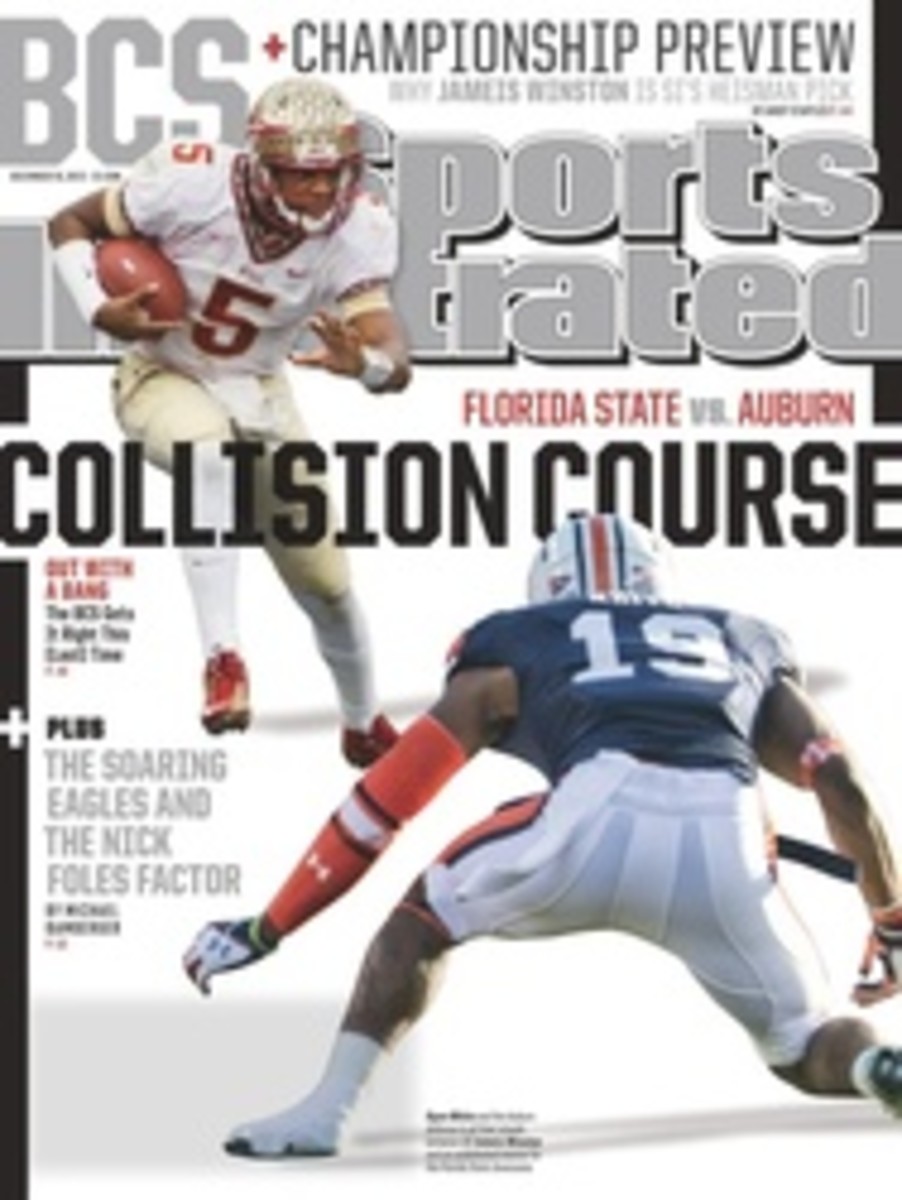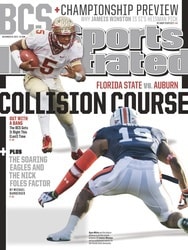
Air Apparent
BIG BOARD
A PERIODIC LOOK AT SOME OF THE MOST INTRIGUING RISING STARS
To spend time with Ayumu Hirano on a day he is not snowboarding is to come away feeling slightly shortchanged. He is an incandescent talent in the halfpipe, barely 15 years old and already nipping at the heels of the best 'boarder in the world. Shaun White, who has won gold in the pipe at the last two Winter Olympics, will head to Sochi in less than two months minus his familiar cape of ginger hair but with a new rival.
Likewise, any journalist laboring to extract sentences from Hirano is nagged by the suspicion that he is being shortchanged a few words. Ayumu speaks little English and isn't especially forthcoming in his native Japanese, preferring to let his actions speak for him. What economical replies he does offer are further compressed when filtered through his translator:
"He's always liked snowboarding better than [skateboarding]."
"He's always enjoyed riding; he's never been afraid."
We don't need a translator to know that Hirano is fearless. That becomes evident on the first hit, or trick, of his run, when he launches a gigantic straight air—soaring up to 24 feet over the lip of the pipe, as if expelled from a circus cannon. He could peruse a paperback up there before descending and completing the rest of his run, which is consistently stylish, technically precise and characterized by that same insane amplitude.
How big can the little guy—he is about 5'2", 115 pounds, in his snowboarding kit—go? At this point in the season, says Hirano's coach, Elijah Teter, "he's going bigger than every single person out there." That includes White, who "may be warming up his tricks," Teter allows. Gearing up for his third Olympics, the 27-year-old White has his drill down by now. He wants to peak in mid-February, not early December.
Hirano's legend was born in March 2011. Too young at 12—according to the rules, at least—to tangle with the big boys at Burton's U.S. Open in Stratton, Vt., he was relegated to the Junior Jams category. Between rounds of the men's halfpipe competition, however, he dropped in and poached a run that would've earned him a spot in the finals had he been eligible. In August 2012 he was invited to compete with the grown-ups at a Burton event in New Zealand. Hirano won. He was 13. The following January he got an invitation to compete in the Winter X Games in Aspen, Colo. On snowboarding's biggest non-Olympic stage, he took silver. The event was won by White, who can be seen on an X Games YouTube video exclaiming, "The Japanese rider who got second is 14 years old. It's amazing!"
Asked if they are on friendly terms, "the Japanese rider" replies, through his translator, "I don't really have much of a relationship with him. But at least he says 'Hi, how's it going?' "
Don't be fooled by the dazzling smile and banter White trots out for public consumption: He is a ferocious competitor. It's not in his nature to befriend a rival, although it wouldn't be surprising to learn that the ex-prodigy harbors some affection for the new prodigy. Their talents are similar, and similarly huge. They have other parallels too.
Shaun White is named after Shaun Tomson, a hard-charging South African surfer and former world champion who was admired by Roger White, Shaun's father. Roger loved surfing; it bummed him out that Shaun didn't. On his first day in the water, in Southern California, Shaun got hit in the face with his board, became hypothermic and never wanted to go back.
Ayumu's father, Hidenori, never did realize his own quixotic dream of becoming a professional surfer. Instead, he opened a surf shop in the coastal city of Murakami and then a skate park. Ayumu doesn't surf much, explaining that the water where he lives is very cold.
Hirano was the youngest athlete in the Winter X Games since 2000—when White competed as a 13-year-old.
There are also similarities on the course, starting with their shared aptitude for amplitude. The ability to go big gives them time in the air to complete the rotations of whatever double-cork trick they're throwing. While some riders appear to be muscling their turns, the very best appear smooth and unhurried.
It remains to be seen if the prodigy shares the former prodigy's nerves of tungsten. Plenty of riders have made runs at White; some have beaten him. But on the day that the eyes of the world are on the sport—the Olympic finals—the challengers have found the moment too big, the pressure too much. White seems to take up residence in their heads.
"When I'm in competition," says Hirano, "I don't care about other riders. I focus on myself. It doesn't really matter who else is riding."
The pipe can be cruel. Kevin Pearce looked like White's biggest threat heading into the 2010 Vancouver Games, but he suffered a traumatic brain injury in a training accident six weeks before the Olympics. His competition days over, Pearce is now a color analyst on the X Games. In September another supremely gifted American rider, Luke Mitrani, was unsuccessful in his attempt to land a frontside double cork 1080, dropping 30 feet out of the sky and fracturing a vertebra. Mitrani may someday return to competition, but he won't be in Sochi.
Neither will Hirano's mentor and countryman, the revered and sometimes iconoclastic Kazuhiro Kokubo. "Kazu" isn't hurt. He's just not that interested in competing in these Olympics, according to Teter, his coach. Kokubo made headlines at the last Olympics for arriving at the Vancouver Games with his tie loose, shirt untucked and trousers sagging; in other words, he dressed like a 'boarder. For his lack of conformity Kazu was forced to issue an apology and suspended from the opening ceremony.
Kokubo is better known, among snowboarders, for winning back-to-back U.S. Opens and for riding with a distinctive style, a panache instantly recognizable in the pipe. While many riders throw the same hits in the same order on each of their runs, ad nauseam, that lack of variety and imagination would bore Kazu. Yes, he wants to win, but he also needs to keep himself interested. In the finals of Winter X two years ago, each of his three runs was completely different.
Kokubo would prefer to sacrifice a half rotation, or a twist, in order to bone a trick—to land it just so. "If he can't do it perfectly," says Teter, "he won't try it." Hirano is in the process of trying to combine Kazu's artistic precision with his own thrilling amplitude.
In explaining how his pupil is able to fly so high, Teter says, "It's really just having the balls to hold on to that speed"—no braking, no slowing, through the transition area and the flat bottom, up the far wall, leading to liftoff. While most riders push off the wall at a slight inward angle—the better to ensure that, upon descending, they don't crash-land on the deck—Hirano goes straight up. "People say, 'Wow, what happens when he catches the lip [with his board on the way down]?' " says Teter. "He's not going to. He practices that timing."
During practice runs before the finals at the last X Games, Hirano launched a bit early on a Cab 1080, caught the deck with the tip of his board and rag-dolled to the bottom, finishing his pratfall in the dread Scorpion position: face-planted, arms trapped behind, body contorted so that the board is touching the snow in front of one's head, like the tail of a scorpion.
Teter was sure Hirano was done for the day. Even though he was hurting, Hirano dusted himself off, then soared to silver, behind Shaun White. He may not be behind White much longer.
White usually takes up residence in his rivals' heads. "When I'm in competition," says Hirano, "I don't care about other riders. It doesn't really matter who else is riding."
SI.COM
RISING STARS
From now through the end of the college and pro football seasons, and leading up to the 2014 Winter Olympics, SPORTS ILLUSTRATED will regularly feature the most intriguing on-the-climb athletes across all its platforms. Look for the latest episode, on Broncos safety Duke Ihenacho, on your computer or mobile device at SI.com/risingstars
PHOTO
Photograph by ERLEND AAS/NTB SCANPIX/REUTERS
SOAR WINNER The diminutive Hirano launches himself nearly 25 feet above the halfpipe.
PHOTO
HANNAH JOHNSTON/GETTY IMAGES

